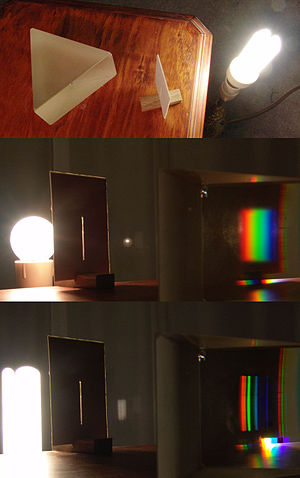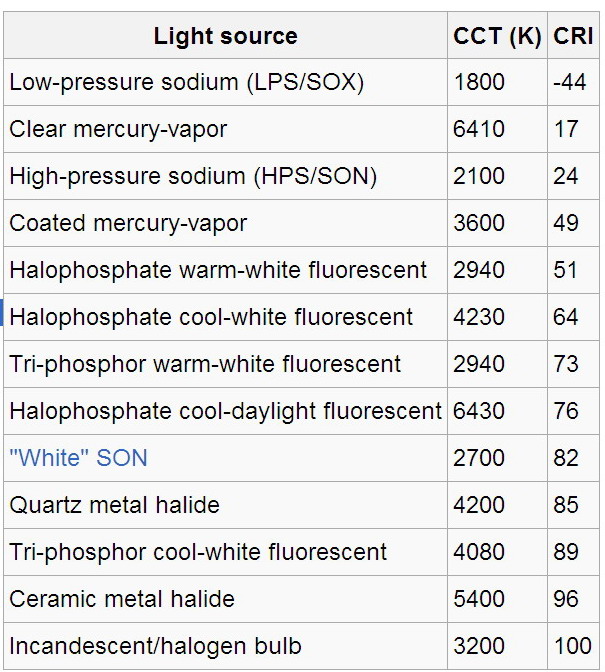The color rendering index (CRI), sometimes called color rendition index, is a quantitative measure of the ability of a light source to reproduce the colors of various objects faithfully in comparison with an ideal or natural light source. Light sources with a high CRI are desirable in color-critical applications such as photography and cinematography. It is defined by the International Commission on Illumination as follows:
Color rendering: Effect of an illuminant on the color appearance of objects by conscious or subconscious comparison with their color appearance under a reference illuminant
The CRI of a light source does not indicate the apparent color of the light source; that information is under the rubric of the correlated color temperature (CCT).
CRI's ability to predict color appearance has been criticized in favor of measures based on color appearance models, such as CIECAM02 and, for daylight simulators, the CIE Metamerism Index. CRI is not a good indicator for use in visual assessment, especially for sources below 5000 kelvin (K).
A newer version of the CRI, R96a, has been developed, but it has not replaced the better-known Ra general color rendering index.

Emitted light spectrum determines the color rendering index of the lamp.
Typical values
reference source, such as blackbody radiation, is defined as having a CRI of 100. This is why incandescent lamps have that rating, as they are, in effect, almost blackbody radiators. The best possible faithfulness to a reference is specified by a CRI of one hundred, while the very poorest is specified by a CRI below zero. A high CRI by itself does not imply a good rendition of color, because the reference itself may have an imbalanced SPD if it has an extreme color temperature.

Criticism and resolution
Ohno (2006) and others have criticized CRI for not always correlating well with subjective color rendering quality in practice, particularly for light sources with spiky emission spectra such as fluorescent lamps or white LEDs. Another problem is that the CRI is discontinuous at 5000 K, because the chromaticity of the reference moves from the Planckian locus to the CIE daylight locus. Davis & Ohno (2006) identify several other issues, which they address in their Color Quality Scale (CQS):
The color space in which the color distance is calculated (CIEUVW) is obsolete and nonuniform. Use CIELAB or CIELUV instead.
The chromatic adaptation transform used (Von Kries transform) is inadequate. Use CMCCAT2000 or CIECAT02 instead.
Calculating the arithmetic mean of the errors diminishes the contribution of any single large deviation. Two light sources with similar CRI may perform significantly differently if one has a particularly low special CRI in a spectral band that is important for the application. Use the root mean square deviation instead.
The metric is not perceptual; all errors are equally weighted, whereas humans favor certain errors over others. A color can be more saturated or less saturated without a change in the numerical value of ∆Ei, while in general a saturated color is experienced as being more attractive.
A negative CRI is difficult to interpret. Normalize the scale from 0 to 100 using the formula 
The CRI can not be calculated for light sources that do not have a CCT (non-white light).
Eight samples are not enough since manufacturers can optimize the emission spectra of their lamps to reproduce them faithfully, but otherwise perform poorly. Use more samples (they suggest fifteen for CQS).
The samples are not saturated enough to pose difficulty for reproduction.
CRI merely measures the faithfulness of any illuminant to an ideal source with the same CCT, but the ideal source itself may not render colors well if it has an extreme color temperature, due to a lack of energy at either short or long wavelengths (i.e., it may be excessively blue or red). Weight the result by the ratio of the gamut area of the polygon formed by the fifteen samples in CIELAB for 6500 K to the gamut area for the test source. 6500 K is chosen for reference since it has a relatively even distribution of energy over the visible spectrum and hence high gamut area. This normalizes the multiplication factor.
Another notable attempt to improve the flaws found in CRI has been in the development in the Gamut Area Index.Rea and Freyssinier have shown that GAI is better than CRI at predicting color discrimination on standardized Farnsworth-Munsell 100 Hue Tests and that GAI is predictive of color saturation. Proponents of using GAI claim that, when used in conjunction with CRI, this method of evaluating color rendering is preferred by test subjects over light sources that have high values of only one measure. Researchers recommend a lower and an upper limit to GAI. Use of LED technology has called for a new way to evaluate color rendering because of the unique spectrum of light created by these technologies. Preliminary tests have shown that the combination of GAI and CRI used together is a preferred method for evaluating color rendering.
Pousset, Obein & Razet (2010) developed a psychophysical experiment in order to evaluate light quality of LED lightings. It is based on colored samples used in the "Color Quality Scale". Predictions of the CQS and results from visual measurements were compared.
CIE (2007) "reviews the applicability of the CIE color rendering index to white LED light sources based on the results of visual experiments." Chaired by Davis, CIE TC 1-69(C) is currently investigating "new methods for assessing the color rendition properties of white-light sources used for illumination, including solid-state light sources, with the goal of recommending new assessment procedures ... by March, 2010."
For a comprehensive review of alternative color rendering indexes see Guo & Houser (2004).
Smet (2011) reviewed several alternative quality metrics and compared their performance based on visual data obtained in 9 psychophysical experiments. It was found that a geometric mean of the GAI index and the CIE Ra correlated best with naturalness (r=0.85), while a color quality metric based on memory colors (MCRI) correlated best for preference (r=0.88). The differences in performance of these metrics with the other tested metrics (CIE Ra; CRI-CAM02UCS; CQS; RCRI; GAI; geomean(GAI, CIE Ra); CSA; Judd Flattery; Thornton CPI; MCRI) were found to be statistically significant with p<0.0001.
Film and video high-CRI LED lighting incompatibility
Problems have been encountered attempting to use otherwise high CRI LED lighting on film and video sets. The color spectra of LED lighting primary colors does not match the expected color wavelength bandpasses of film emulsions and digital sensors. As a result, color rendition can be completely unpredictable in optical prints, transfers to digital media from film (DI's), and video camera recordings. This phenomenon with respect to motion picture film has been documented in an LED lighting evaluation series of tests produced by the Academy of Motion Picture Arts and Sciences scientific staff.





